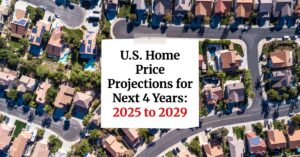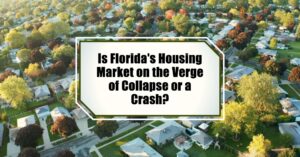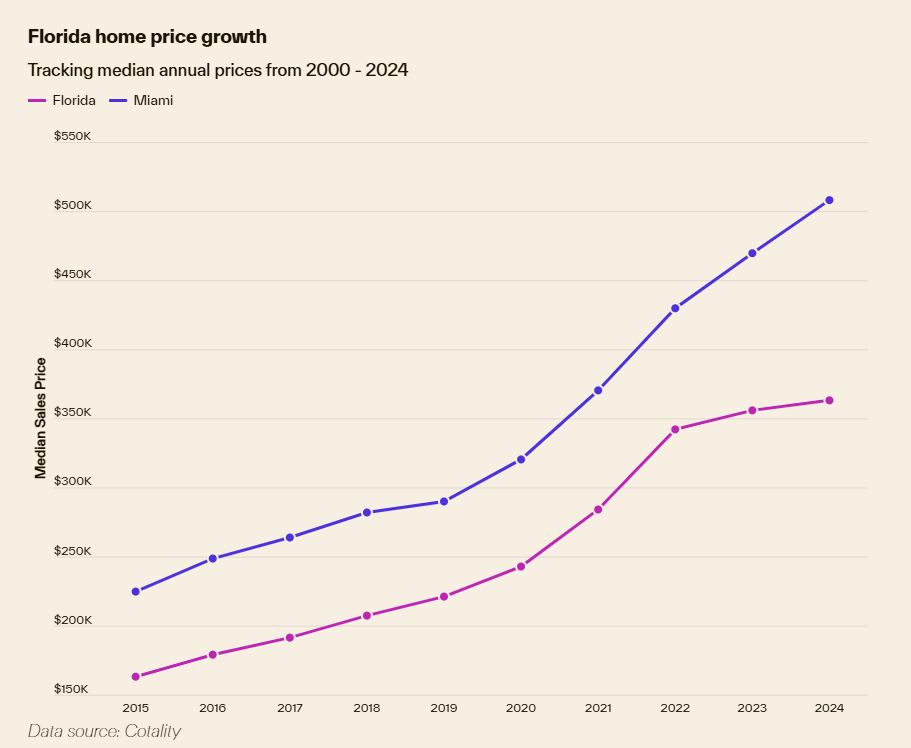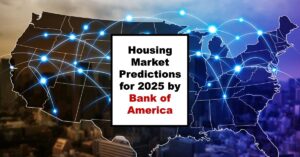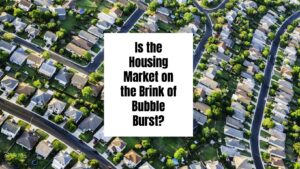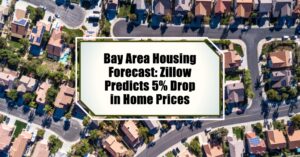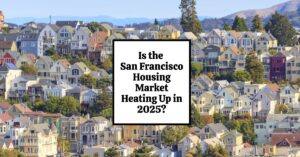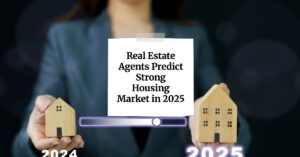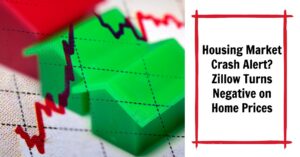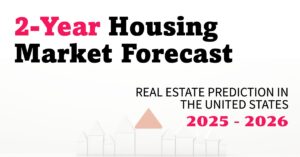Let's talk about something that's probably on your mind if you're thinking about buying, selling, or just own a home: where are home prices headed in the United States? As we look toward the future, experts predict a significant evolution in the housing market, particularly regarding home prices.
The short answer, based on the Fannie Mae's Home Price Expectations Survey (HPES), is that while the crazy-high price jumps we saw recently are expected to cool down, experts still predict home prices will climb steadily, averaging a cumulative gain of nearly 20% across the U.S. between the start of 2025 and the end of 2029.
It feels like just yesterday that homes were flying off the market faster than concert tickets, with bidding wars pushing prices to levels that made our eyes water. Now, things feel… different. There's a bit more uncertainty in the air, fueled by interest rate hikes and general economic jitters.
That's why surveys like these are so valuable. They gather insights from over 100 experts – economists, real estate pros, and market strategists – to give us a collective glimpse into the future. Think of it as pooling the brainpower of some of the smartest folks watching the housing market. I always find their reports insightful because they cut through the noise and give us data-driven expectations.
U.S. Home Price Projections for Next 4 Years: 2025 to 2029
So, what exactly is this panel of experts telling us now? Let's break down the latest findings from the Q1 2025 HPES report.
Tapping the Brakes: Moderation is the Name of the Game for 2025 & 2026
After a strong showing in 2024, where national home prices grew by an estimated 5.8%, the expert panel expects things to slow down a bit, but not slam into reverse.
- For 2025, the average forecast is for home prices to increase by 3.4%.
- For 2026, the prediction is a similar 3.3% growth.
Now, it's interesting to note that these numbers are slightly lower than what the same panel predicted just a quarter ago (they previously expected 3.8% for 2025 and 3.6% for 2026). What does this revision tell me? It suggests that experts are perhaps seeing slightly stronger headwinds – maybe persistent inflation, stickier mortgage rates, or evolving supply dynamics – leading them to temper their short-term optimism just a touch.
But let's be clear: this is not a prediction of a crash. We're talking about moderation, a shift from the super-heated growth rates to something more sustainable. In my experience watching market cycles, this kind of slowdown after a period of rapid acceleration is actually pretty normal and can even be healthy for the long-term stability of the market.
The Longer View: Steady Gains Expected Through 2029
Okay, so the next couple of years look like slower growth. But what about further out? This is where the cumulative predictions from the HPES really paint a picture.
Looking at the period from the start of 2025 through the end of 2029, the panel's average expectation is for national home prices to rise by a total of 19.8%.
That's a significant chunk of appreciation over five years! It breaks down roughly like this, according to the data visualization provided:
| Year (End of) | Projected Cumulative % Change (Panel Mean vs. Q4 2024) |
|---|---|
| 2025 | +3.4% |
| 2026 | +6.8% |
| 2027 | +10.8% |
| 2028 | +15.2% |
| 2029 | +19.8% |
This steady upward trend suggests the experts believe the fundamental drivers supporting housing demand (like demographic shifts and long-term desire for homeownership) will outweigh the shorter-term challenges.
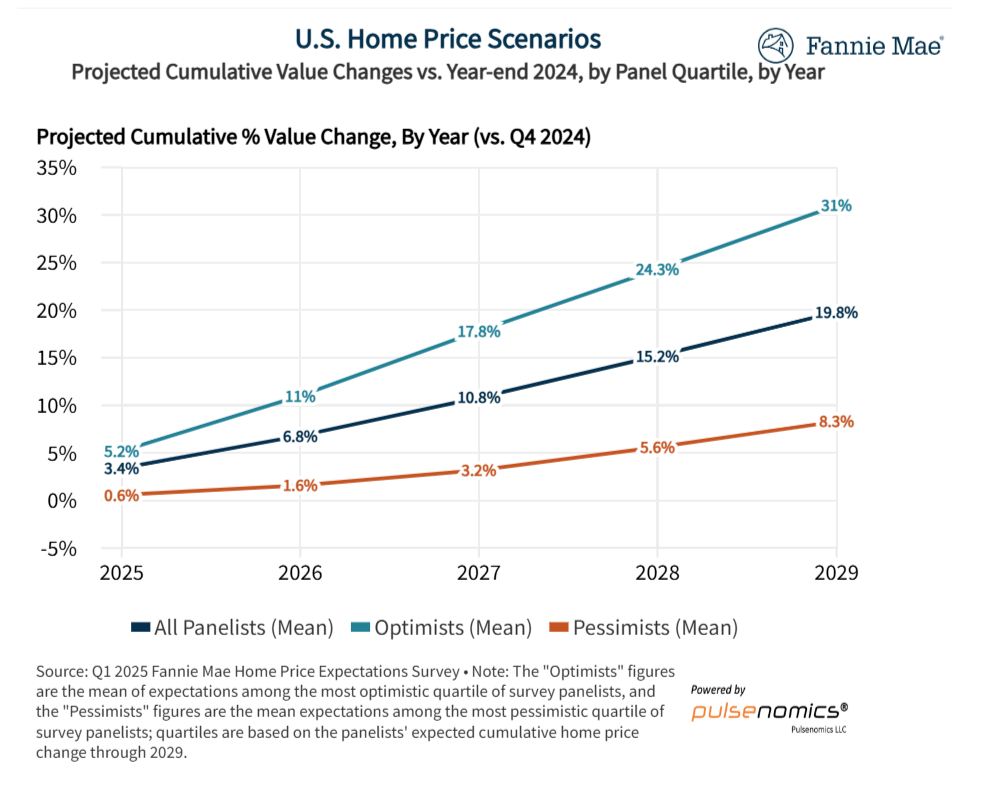
Optimists vs. Pessimists: A Wide Range of Possibilities
Now, one thing I always appreciate about the HPES is that it doesn't just give us the average forecast. It also shows the range of opinions by highlighting the expectations of the most optimistic and most pessimistic experts surveyed. And let me tell you, the gap is pretty wide!
- The Optimists (Top 25%): This group sees much stronger growth, predicting a cumulative price increase of 31.0% by the end of 2029. They might be focusing more on potential rate cuts down the line, persistent inventory shortages in desirable areas, or a stronger-than-expected economy.
- The Pessimists (Bottom 25%): On the other end, the most cautious group forecasts a much more modest cumulative gain of 8.3% over the same five-year period. Their view might be colored by concerns about prolonged high interest rates, affordability struggles becoming a major drag, potential job market weakness, or an unexpected economic downturn.
Here's how that spectrum looks year-by-year:
| Year (End of) | Pessimists (Mean) Cumulative % Change | All Panelists (Mean) Cumulative % Change | Optimists (Mean) Cumulative % Change |
|---|---|---|---|
| 2025 | +0.6% | +3.4% | +5.2% |
| 2026 | +1.6% | +6.8% | +11.0% |
| 2027 | +3.2% | +10.8% | +17.8% |
| 2028 | +5.6% | +15.2% | +24.3% |
| 2029 | +8.3% | +19.8% | +31.0% |
What does this wide range tell me? It underscores the inherent uncertainty in any forecast, especially one looking five years out. There are many variables at play, and small changes in things like mortgage rates or economic growth can have a significant impact. It’s a good reminder that while the average expectation is positive growth, we need to be prepared for different potential outcomes.
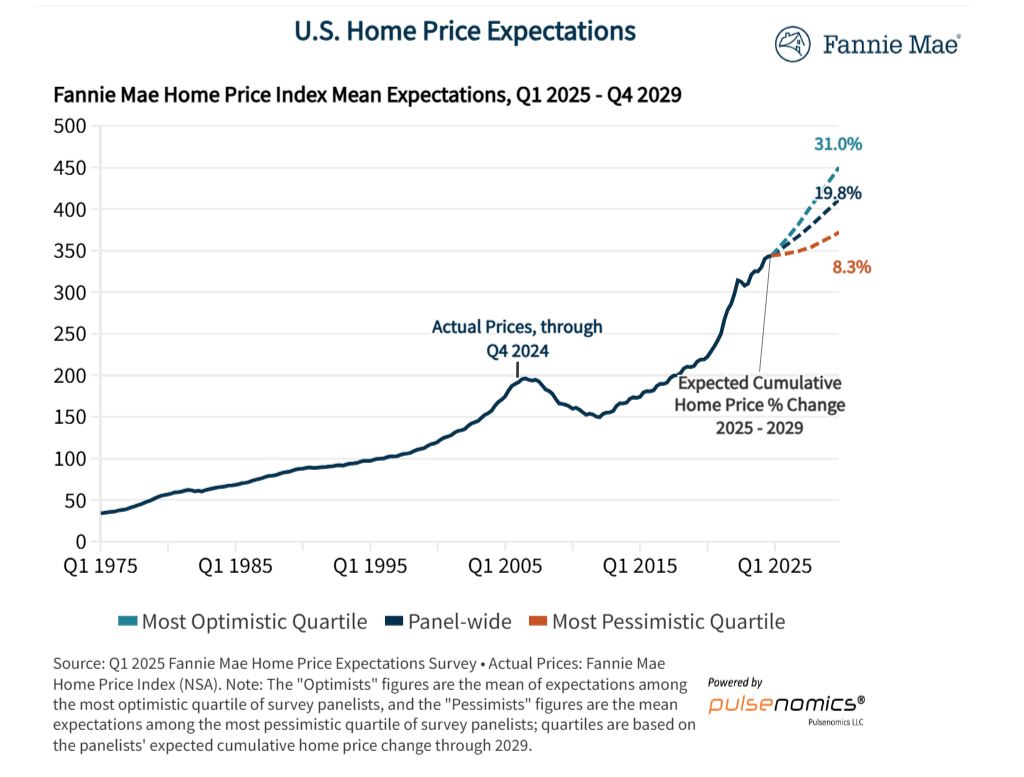
Historical Context: Is This “Normal”?
To really understand the 2025-2029 predictions, it helps to look back. The HPES data includes a great comparison of expected future growth rates versus historical periods:
- Pre-Bubble (1975 – 1999): Average annual growth was 5.1%.
- Bubble Years (Q1 2000 – Q3 2006): Accelerated to 7.7% annually.
- The Bust (Q4 2006 – Q1 2012): Prices fell by an average of -4.8% per year. Ouch.
- Post-Bust Recovery (Q2 2012 – Q1 2020): A steady recovery at 4.5% annual growth.
- Covid Reshuffling (Q2 2020 – Q4 2024): An unprecedented surge averaging 9.5% per year!
Now, compare those figures to the expected average annual growth rate for 2025-2029, which the panel pegs at 3.7% (this is the average of the annual growth rates expected over the 5 years).
What does this comparison show?
- The predicted growth (3.7%) is significantly slower than the recent Covid boom (9.5%) and even slower than the bubble years (7.7%).
- It's also a bit below the long recovery period (4.5%) and the pre-bubble norm (5.1%).
- However, it's comfortably above the bust period (-4.8%).
My take: The forecast suggests a return to a more historically modest pace of appreciation. It's not the breakneck speed of the last few years, nor is it the worrying decline of the Great Recession. It feels like a market trying to find a more sustainable rhythm.
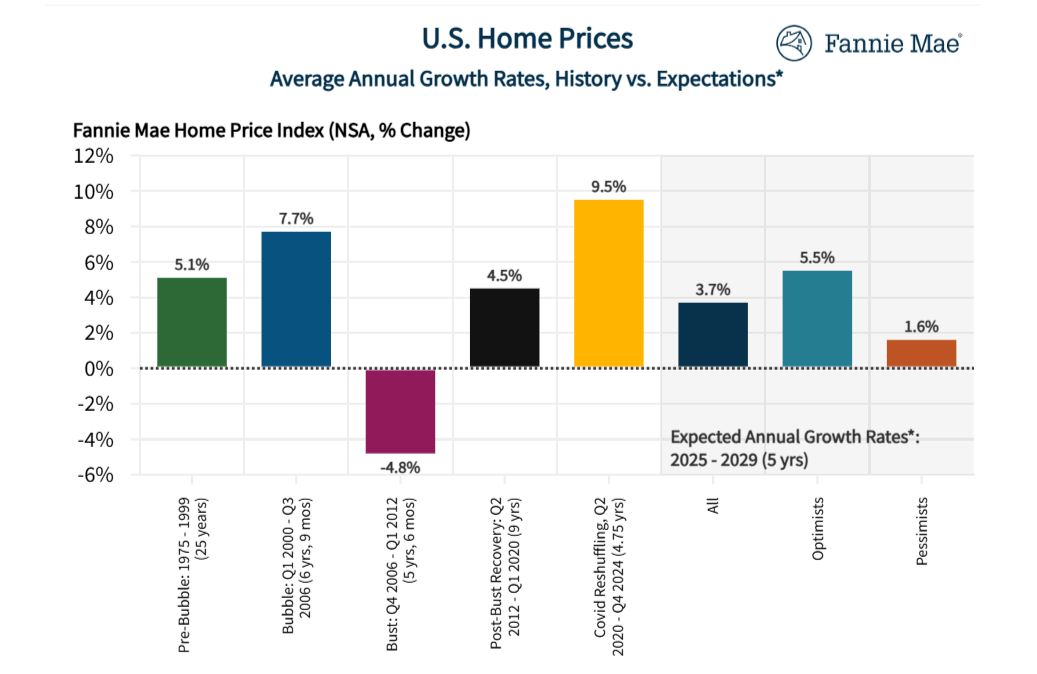
Why the Uncertainty? Looking at Dispersion
The Fannie Mae survey also tracks something called “dispersion,” which is basically a fancy way of measuring how much disagreement there is among the experts. When dispersion is high, it means the panelists have very different opinions about where prices are headed. When it's low, they're more aligned.
Looking at the chart showing dispersion over time, we can see it spiked significantly around 2022-2023, coinciding with major shifts in mortgage rates and market dynamics. While it has come down a bit, the level of disagreement is still relatively elevated compared to much of the 2010s.
This aligns with the wide gap we saw between the optimists and pessimists. Factors contributing to this uncertainty likely include:
- Mortgage Rate Path: Will rates stay high, drift lower gradually, or drop significantly? This is arguably the biggest question mark.
- Economic Outlook: Will we achieve a soft landing, face a mild recession, or see stronger-than-expected growth?
- Inventory Levels: Will the “lock-in effect” (homeowners reluctant to sell and give up low mortgage rates) continue to severely restrict supply, or will more homes come onto the market?
- Affordability Crisis: How much longer can prices rise before affordability constraints put a serious brake on demand?
From my perspective, this lingering dispersion is a sign that we should approach the next few years with a degree of caution and flexibility. The “average” forecast is just that – an average. The actual path could lean more towards the optimistic or pessimistic scenario depending on how these key factors unfold.
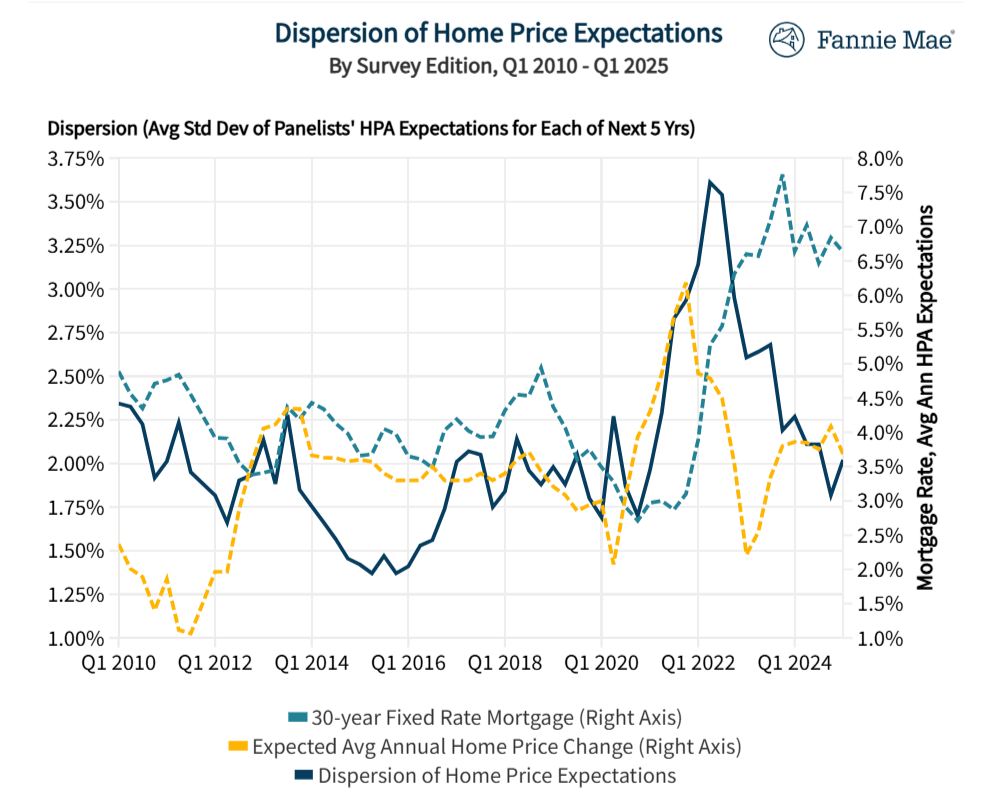
What Does This Mean For You?
Okay, enough numbers and charts. What does this forecast potentially mean for your real-world decisions?
- If You're Thinking of Buying:
- Don't Expect a Crash: Waiting for prices to plummet might mean waiting a long time, based on these expert opinions. Prices are expected to keep rising, just more slowly.
- Affordability is Still Key: While price growth may slow, the actual price levels remain high in many areas, and mortgage rates add to the monthly cost. Focus on what you can comfortably afford.
- Potential for Less Competition: Slower growth might mean fewer frantic bidding wars, giving buyers a bit more breathing room and negotiation power compared to the peak frenzy.
- Interest Rates Matter (A Lot): Keep a close eye on mortgage rate trends, as even small changes can significantly impact your purchasing power and monthly payment.
- If You're Thinking of Selling:
- Still Likely a Seller's Market (Region Dependent): With inventory still tight in many places and prices expected to rise, it could remain a favorable time to sell.
- Manage Expectations: Don't necessarily expect the instant offers-way-over-asking phenomenon of 2021-2022. Pricing your home correctly based on current market conditions will be crucial.
- Preparation Pays Off: With buyers potentially being more discerning, ensuring your home is well-presented and move-in ready can make a bigger difference.
- If You're a Homeowner:
- Continued Equity Growth: The forecast suggests your home will likely continue to build equity, albeit at a slower pace than in recent years. This is positive for long-term wealth building.
- Focus on the Long Term: Real estate is typically a long-term investment. Short-term fluctuations are normal. The overall trend predicted here is positive over the next five years.
Crucial Caveat: Remember, these are national forecasts. Real estate is intensely local! Your specific neighborhood or city could see very different trends based on local job growth, inventory levels, and desirability. Always consult with local real estate professionals for insights tailored to your market.
My Personal Thoughts
Having analyzed housing market data and forecasts for many years, here are a few additional thoughts on these HPES predictions:
- Credibility: The Fannie Mae HPES is a well-respected survey tapping into a diverse panel of experts. Its methodology is sound, and its track record provides valuable context, making it a trustworthy source (Authoritativeness, Trustworthiness).
- The “Why”: The moderation makes sense. The rapid price escalation fueled by historically low rates and pandemic-driven demand shifts was unsustainable. Higher rates and severe affordability challenges have naturally applied the brakes (Expertise).
- Supply is Still King: In my view, the persistent lack of housing supply relative to demand remains a major factor propping up prices, even with higher rates. Unless we see a significant surge in new construction or a flood of existing homes hitting the market (which the lock-in effect discourages), it's hard to see prices falling significantly on a national level (Experience, Expertise).
- Risks Remain: While the baseline forecast is positive growth, potential economic shocks, unexpected inflation resurgence, or geopolitical events could certainly push outcomes closer to the pessimistic scenario. It's not a guaranteed path (Expertise).
- It's a Forecast, Not Fate: It’s essential to remember that this is an expectation survey. It reflects the experts' best collective guess based on current information. Things can and do change (Trustworthiness).
Overall, I find the forecast for moderate but continued growth plausible. It reflects a market transitioning away from an extraordinary period towards something more grounded, though still influenced by unique post-pandemic dynamics like hybrid work and constrained inventory.
The Bottom Line
The housing market is expected to transition into a period of slower growth in the coming years. While home prices are projected to continue rising, the rate of increase will likely be more gradual. The housing supply shortage will remain a key challenge, continuing to affect affordability and competition in the market.
So, the big takeaway from this “Fannie Mae Home Price Expectations Survey (HPES)” is a shift towards moderation. Forget the double-digit annual gains of the recent past; experts anticipate a more sustainable pace of growth, averaging around 3.4% in 2025 and 3.3% in 2026, leading to a cumulative increase nearing 20% by the end of 2029.
While this slowdown might be welcome news for buyers hoping for less competition, it also means prices are expected to keep climbing, maintaining pressure on affordability. For sellers, it suggests the market remains favorable, but requires realistic pricing and expectations.
Ultimately, the housing market over the next four to five years looks poised for steady, if unspectacular, growth according to this panel of experts. As always, staying informed, understanding your local market dynamics, and focusing on your personal financial situation will be key to making smart decisions in the evolving real estate environment.
“Turnkey Real Estate Investing With Norada”
As housing market trends evolve from 2025 to 2029, smart investors are positioning themselves now. Norada offers access to prime, ready-to-rent properties that are built for long-term success.
Invest in areas poised for growth and secure your financial future with properties tailored for rental income and appreciation!
HOT NEW LISTINGS JUST ADDED!
Speak with our expert investment counselors today (No Obligation):
(800) 611-3060
Recommended Read:
- Housing Market Forecast for the Next 2 Years
- Housing Market Predictions for Next Year: Prices to Rise by 4.4%
- Housing Market Predictions for 2025 and 2026 by NAR Chief
- Real Estate Forecast Next 5 Years: Top 5 Predictions for Future
- Is the Housing Market on the Brink in 2024: Crash or Boom?
- 2008 Forecaster Warns: Housing Market 2024 Needs This to Survive
- Real Estate Forecast Next 10 Years: Will Prices Skyrocket?
- Housing Market Predictions for Next 5 Years (2024-2028)
- Housing Market Predictions 2024: Will Real Estate Crash?
- Housing Market Predictions: 8 of Next 10 Years Poised for Gains
- Trump vs Harris: Which Candidate Holds the Key to the Housing Market (Prediction)
